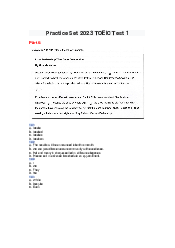



Preview text:
UNIT 1 HOMEWORK Task 1
Drucker listed 5 tasks of a manager: 1. planning 2. organizing 3. integrating 4. measuring performance 5. developing people A - 1 F - 1 J - 5 B - 2 G - 2 K - 3 C - 3 H - 1 L - 3 D - 1 I - 3 M - 3 E - 4 TASK 2 True or False?
1. A company’s top managers need to take only the current situation of their company into account. False
2. The management board of a company should be flexible when dealing with its problems. True TASK 3
What does each of the underlined part refer to?
1. “Drucker was an American business professor and consultant who is often called
things like ‘The Father of Modern Management’. --> Drucker
2. “. . . and for each individual member of are being achieved. it → the organization TASK 4
Find words in the text with the following meanings: a) Goals = objectives
b) an urgent, difficult or dangerous situation = crisis
c) succeed in achieving something = attain
d) people who have lower positions and less power in an organization=subordinates
e) make small changes to improve something = modify TASK 5
Fill in the blanks with a correct preposition
1. The success or failure of a company depends __
___ the quality of their managers. on
2. One well-known classification of the tasks of a manager comes _ from______ Peter Drucker.
3. According to Drucker, the work of a manager can be divided __into____ five tasks
4. Managers have to communicate objectives _ to___ the people responsible _ for_____ attaining them.
5. They have to work ___with____ people in other areas and functions
6. Managers have to see whether the objectives or targets set ___ ____ the for
organization are being achieved.
7. Top managers have to manage a business’s relations ___with____ customers, suppliers and so on. 8. They have to deal ___ ____ any crisis that arises. with
9. Some people are good __at____ management.
10. Some people will be unable to put management techniques __ _____ practice. into TASK 6
Read the article below about management.
Choose the best word to fill each gap.
Management is the (1) ………. of an organization, whether it is a business, a not-for-
profit organization, or government body. Management includes the activities of (2)
………. the strategy of an organization and coordinating
(sự điều phối/phối hợp) the
efforts of its employees (3) ………. its objectives through the application of
available resources, such as financial, natural, technological, and human resources.
The term "management" may also refer (4) ………. those people who manage an
organization - managers.
Some people study management at colleges or universities; major degrees in
management (5) ………. the Bachelor of Commerce (B.Com.), Bachelor of Business
Administration (BBA.), Master of Business Administration (MBA.), Master in
Management (MScM or MIM) and, for the public sector, the Master of Public
Administration (MPA) degree. Individuals who aim (6) ………. management specialists
or experts, management researchers, or professors may complete the Doctor of
Management (DM), the Doctor of Business Administration (DBA), or the PhD in
Business Administration or Management.
Larger organizations generally have three (7) ………. levels of managers, in a pyramid structure:
Senior managers, such as members of a board of directors and a chief executive
officer (CEO) or a president of an organization. They set the strategic goals of
the organization and make decisions (8) ………. how the overall organization
will operate. Senior managers are generally executive-level professionals,
and provide direction to middle management, who directly or indirectly report to them.
Middle managers - examples of these would include branch managers, regional
managers, department managers and section managers, (9) ………. provide
direction to front-line managers. Middle managers communicate the strategic
goals of senior management to the front-line managers.
Lower managers, such as supervisors and front-line team leaders, (10) ………. the
work of regular employees and provide direction on their work.
In smaller organizations, a manager may have a much wider scope and may perform
several roles or even all of the roles commonly observed in a large organization. 1. A expansion B administrative C administration D administer 2. A B C D setting set addition extending 3. A B accomplished accomplishing C accomplishment D to accomplish 4. A B C to at for D about 5. A found B C include restrain D extend 6. A become B becoming C progress D to become 7. A hierarchy
B hierarchical (thứ bậc) C D hierarchically structure 8. A B C D on in at for 9. A which B what C those D who 10. A overdo B oversell C oversee (giám sát) D outdo




